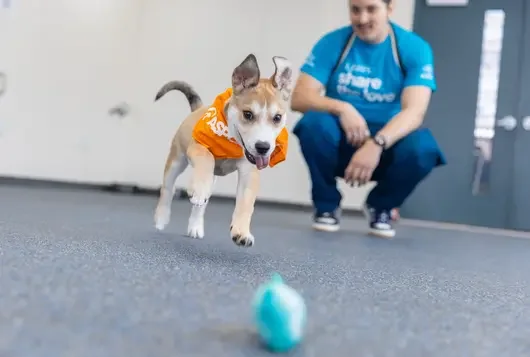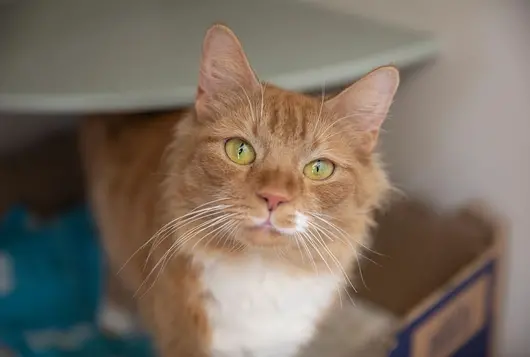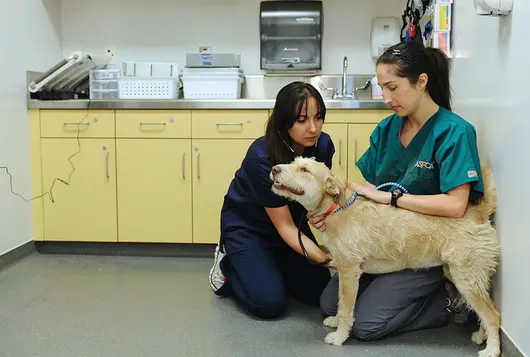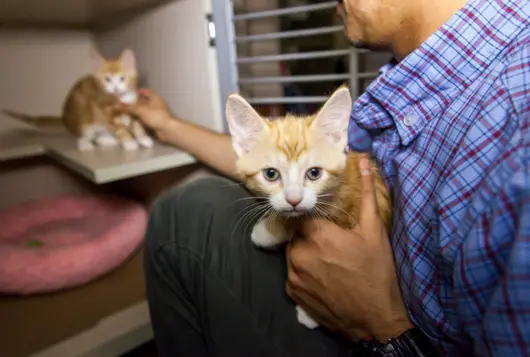Feline Infectious Peritonitis
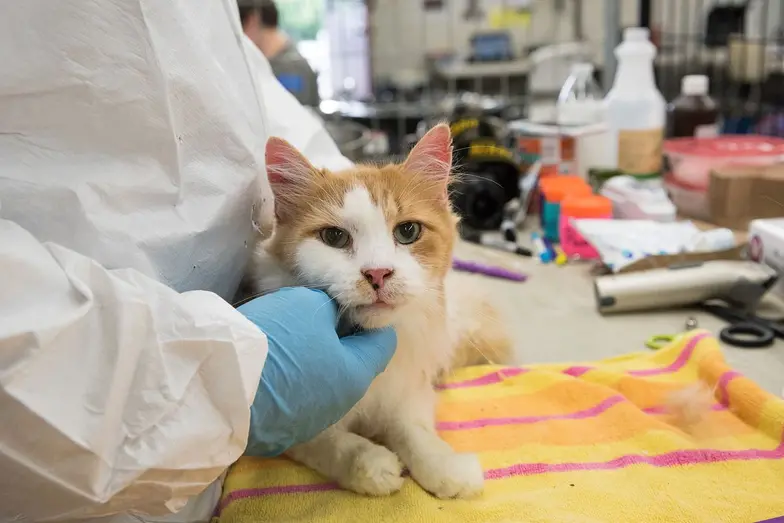
Feline Infectious Peritonitis (FIP) is a disease caused by mutation of the feline enteric coronavirus (FECV). FECV typically causes mild diarrhea and is commonly found in clinically healthy cats and kittens. FECV can potentially mutate into the feline infectious peritonitis virus (FIPV) in some cats. FIPV causes a severe inflammatory response in infected cats, causing the disease known as Feline Infectious Peritonitis (FIP).
FIP is an uncommon disease and tends to affect young cats and kittens. There are two forms of FIP: the effusive (wet) form, which involves fluid accumulation in body cavities, and the non-effusive (dry) form, which is more insidious and difficult to diagnose. FIP is a complex disease, and many aspects are still not fully understood. Outbreaks of FIP are rare but possible in animal shelters.
Historically, FIP was considered to be invariably fatal, and euthanasia was the most humane decision for animals with this disease. Recent advances in treatment have made live outcomes for cats and kittens with FIP possible. Despite strides in FIP treatment, the decision of whether or not to treat FIP in the shelter setting remains a complex topic with several factors to consider.
What You Should Know
Historically, FIP has been classified as one of two forms: effusive (wet) and non-effusive (dry). FIP is now better understood as a spectrum of clinical presentations. The clinical signs of FIP can vary and many signs are non-specific, including:
- Fever
- Lethargy
- Poor appetite
- Weight loss or poor growth
- Ascites (abdominal distension due to fluid accumulation)
- Difficulty breathing
- Icterus (jaundice, or yellow-tinted skin)
- Pale mucous membranes
- Ocular abnormalities (such as uveitis, iritis, retinitis and keratic precipitates)
- Neurological abnormalities (such as ataxia, seizures or paresis/paralysis)
Feline enteric coronavirus (FECV) is a ubiquitous virus, especially in high-density settings such as shelters. Following exposure to FECV, 5-10% of cats will resist the virus, 70-75% will undergo a transient infection for weeks to months, 10-15% will become chronic shedders and less than 3% will develop FIP. The feline coronavirus is shed in the feces of infected cats and the primary mode of transmission is through the fecal-oral route. Fecal particles contaminate the environment, especially litter boxes, food bowls and shared living spaces. Cats become infected by ingesting particles from contaminated surfaces. Many cats infected with FECV appear healthy or may have mild diarrhea. Some infected cats can shed FECV intermittently for months or years. Thankfully, FIPV is rarely transmitted between cats. Asymptomatic infection and intermittent shedding make eliminating exposure to FECV difficult. Despite this, there are ways that shelters can minimize FIP in their populations.
Human Health Considerations
Feline coronaviruses do not infect humans and are not the same as SARS-CoV-2 (COVID-19).
Diagnosing FIP can be challenging because there is no single diagnostic test that’s both definitive and easily performed in a live animal. Furthermore, testing for FECV is unrewarding since FECV infection is common and frequently subclinical. Signs of FIP are often non-specific and can mimic many other diseases, such as cancer, heart failure, toxoplasmosis, FeLV and more. A presumptive FIP diagnosis is often made by considering signalment, clinical signs and diagnostic test results.
Blood Tests: Bloodwork results such as non-regenerative anemia, lymphopenia, hyperproteinemia, hyperbilirubinemia, elevated liver enzymes and elevated blood globulin levels can be seen in cats with FIP. A low albumin-to-globulin ratio in serum or elevated gamma-globulins can suggest FIP. Serology for feline coronavirus antibodies is evidence of prior exposure, but testing cannot distinguish between FECV and FIPV. A negative antibody test can help rule out FIP, but a positive antibody test alone does not confirm FIP diagnosis.
Fluid Analysis: Cats with “wet” FIP can produce a characteristic “straw-colored”, viscous fluid with high protein content (albumin: globulin ratio less than 0.8 and total protein greater than 3.5 mg/dL) and low cellularity (primarily neutrophils and macrophages).
PCR: PCR can help identify FIP-associated mutations in the spike protein associated with FIPV. PCR is a helpful test when used on effusions or tissue samples, but PCR is not recommended on blood or fecal samples.
Imaging: Radiographs or ultrasound may show evidence of free fluid (effusion) in the chest or abdomen. Granulomas (inflammatory nodules) may also be seen on organs and lymph nodes may be enlarged (especially the lymph nodes that are associated with the intestines).
Biopsy: Histopathology and immunohistochemistry on tissue samples can definitively diagnose FIP. This method is invasive and involves collecting tissue samples from affected organs, then analyzing them for hallmark signs of pyogranulomatous inflammation and vasculitis and detecting viral antigens inside macrophages.
Post-Mortem Diagnosis: Necropsy findings typically include free fluid (effusions) and nodules (pyogranulomatous inflammatory masses). Specialized testing of tissue samples can be used to confirm FIP post-mortem.
Individual Cats:
Until recently, treatment for FIP was limited and prognosis was considered grave due to the rapid progression of the disease. For this reason, humane euthanasia of affected cats has long been the recommendation to prevent suffering. Recent advances in antiviral treatments have made the treatment of cats with FIP possible, expanding possible outcomes for shelter cats with this disease.
GS-441524 is the most effective antiviral treatment currently available for FIP. In the spring of 2024, GS-441524 became available as a compounded oral formulation. With early intervention and consistent treatment, many cats can achieve remission, though some cats will relapse. Cats with advanced neurologic or ocular involvement may continue to have a guarded prognosis. Treatment with GS-441524 typically consists of 12 weeks of daily oral medication, but length of treatment may vary based on severity of disease and response to treatment. Antiviral treatment with GS-441524 can cost several thousand dollars.
In addition to antiviral treatment, cats with FIP require close monitoring of clinical signs, recheck lab work and nursing care. Supportive care treatments typically include fluids to support hydration, nutritional support (if not eating), anti-inflammatory drugs and pain medication to maintain comfort. Cats with fluid accumulation may also need to have effusions drained to relieve discomfort and allow them to breathe comfortably. Cats with neurologic abnormalities may require anticonvulsant medication. When relapses occur, cats may need a second round of antiviral treatment. Without treatment, FIP remains fatal in nearly all cases.
The development of safe and effective FIP treatments offers hope to many cat lovers. However, shelters must carefully consider several factors before deciding to treat FIP. The organization’s mission and the needs of the animals it serves should be evaluated to ensure that FIP treatment aligns with the shelter's goals. Resources like the cost of antiviral medications, staff time and daily care should also be taken into account, as they may limit treatment feasibility. Most importantly, shelters must assess their capacity to ensure all animals' welfare is prioritized before starting a FIP treatment program. Given the challenges of FIP treatment in shelters, euthanasia remains a humane option for cats with FIP.
Population-Level Implications:
FIP outbreaks are uncommon since the mutated version of the virus (FIPV) is rarely transmitted between cats. Mixing litters of kittens and having large groups of cats (or rapid turnover of cats) in group housing can increase the risk of transmission and therefore the potential for outbreaks. Some strains of FECV may be more transmissible and may increase the risk of FIPV transmission.
Additionally, some cats may have a genetic predisposition to developing FIP. For this reason, littermates of kittens that develop FIP are considered at increased risk for developing FIP due to shared genetics, similar exposure history to a potentially virulent strain of FECV and shared historical stressors. Unrelated cats exposed to a cat with FIP are considered low risk for developing FIP. Littermates of affected cats should be closely monitored for clinical signs of FIP.
Fosters who have cared for a cat or kitten with FIP should thoroughly disinfect all contaminated surfaces before introducing another cat or kitten to the environment. If contaminated surfaces cannot be appropriately disinfected, then a 2-month waiting period is recommended based on the viability of the virus in the environment.
Appropriate disclosure of exposure history and risk is also recommended for littermates of kittens with FIP. It can take months or years for FIP to develop after exposure and there are currently no tests that can predict the likelihood of FIP developing in exposed cats. Shelters can expect to see occasional cases of FIP, with an incidence of less than 1% being considered unavoidable. A thorough investigation is warranted when a shelter detects an incidence of FIP higher than 1%, including evaluation of cleaning and disinfection protocols, group housing guidelines and stress reduction efforts (such as kennel design and enrichment).
Understanding the various risk factors for cats developing FIP can help guide prevention efforts. While there is a vaccine available for feline coronavirus, vaccination is not recommended due to poor efficacy. Instead, management strategies that reduce exposure to FECV in the environment, prevent overcrowding in the shelter and support immune system health can help prevent FIP in the shelter.
Foster-based Kitten Care
Young cats and kittens are at increased risk for developing FIP. Kittens are naturally immunosuppressed due to having immature immune systems. Kittens also have an increased risk of exposure to high viral loads and often experience multiple stressful events, including illness, vaccination, surgery, and unstable living conditions. Interestingly, most cats that develop FIP do so after their first exposure to FECV. These factors make kittens the most vulnerable population to FIP in the shelter. Housing kittens separately from adults and refraining from mixing litters is recommended. Prioritizing foster placement for kittens and minimizing their length of stay in the shelter is recommended.
Sanitation
Reducing FECV (the precursor to FIPV) in the environment can help reduce the occurrence of FIP by reducing the viral load that the cat is exposed to in the shelter. Feline coronavirus can survive for 7 weeks in dry environments. Thankfully, FECV is easily inactivated by many common disinfectants. Adhering to good sanitation practices is key to reducing exposure to FECV in the environment. Litter boxes should be scooped and cleaned at least once daily. Disposable litter boxes can be considered for cats and kittens with diarrhea. Feces should always be removed promptly and surfaces should be cleaned with an effective disinfectant. Limit the mixing of animals in group housing to reduce exposure to FECV. Shared items (such as litter boxes, food bowls, bedding, toys, etc.) and living spaces should be regularly cleaned, even when no signs of illness are noted in the population. Spot cleaning is recommended on a daily basis, and deep cleaning is recommended between cats.
Stress Reduction
Stress can contribute to disease by impairing immune function. Reducing length of stay in the shelter is one of the most effective ways to reduce stress and support shelter animal health. Additionally, providing cats with humane housing (ideally double-compartment housing) that is socially stable, enriched, and appropriate in size can reduce stress. Noise reduction, gentle animal handling, and prompt medical care are more ways we can support shelter animal health and well-being.
Population Management
Overcrowding increases the risk of many diseases, including FIP, in the shelter. When shelters operate over their capacity for care there is a greater risk of disease introduction into the shelter, increased contact between animals, increased stress, and compromised animal care. Crowded conditions can also increase viral load in the shelter, leading to increased transmission through contact and fomites. Proactive population management strategies, such as pathway planning using shelter rounds, can help shelters function within their capacity for care. Population management strategies that promote pathway planning and minimize length of stay help other preventive strategies (such as stress reduction and sanitation) to be most effective. One study found that cats with a length of stay over 60 days were 5 times more likely to test positive for feline coronavirus compared to cats with length of stay less than 5 days.
Treatment of FIP may require months of medical care. The prolonged course of treatment can increase length of stay in the shelter and thereby reduce the shelter’s ability to provide appropriate care to other animals in the shelter. If a shelter chooses to treat FIP, foster placement should be considered during treatment or with foster-based rescue groups resourced to support these special cats.
If your shelter chooses to treat cats with FIP, appropriate counseling for fosters and adopters is recommended to convey the uncertain prognosis (even with treatment) and the potential (though low) for spread. Fosters and adopters should be aware of the clinical signs to monitor and be prepared to provide follow-up medical care, as needed.

